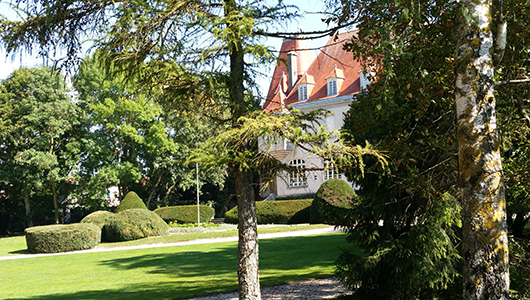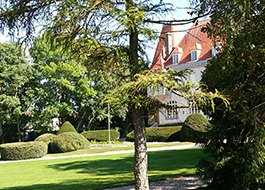Thorey-Lyautey
Durée visite : 60 minutes
Moyen : Pédestre
Thorey vient du nom d’un homme Taurius, issu du mot latin taurus, taureau, avec le suffixe acum la propriété. Des vestiges gallo-romains ont été découverts dans la commune. Depuis 1793, ce modeste village n’a jamais compté plus de 300 habitants. Il est essentiellement connu par l’un d’entre eux, le maréchal Lyautey. Son nom est d’ailleurs accolé à celui de Thorey.
Hubert Lyautey est né à Nancy en 1854. Il est mort en 1934 à Thorey. Il fut officier pendant les guerres coloniales, premier résident général du protectorat français au Maroc en 1912, ministre de la Guerre lors de la Première Guerre mondiale, puis maréchal de France en 1921. Académicien, il fut aussi président d’honneur des trois fédérations des Scouts de France. Il a épousé, en 1909, Inès de Bourgoing à Paris. Sa devise, empruntée au poète anglais Shelley, mais en fait tirée de Shakespeare, est restée célèbre : La joie de l’âme est dans l’action. Inhumée d’abord au Maroc, sa dépouille est transférée aux Invalides, en 1961.
Thorey comes from the name of a man Taurius, derived from the Latin word taurus, bull, with the suffix acum the property. Gallo-Roman remains have been discovered in the town. Since 1793, this modest village has never counted more than 300 inhabitants. He is mainly known by one of them, Marshal Lyautey. His name is also attached to that of Thorey. Hubert Lyautey was born in Nancy in 1854. He died in 1934 in Thorey. He was an officer during the colonial wars, first general resident of the French protectorate in Morocco in 1912, Minister of War during the First World War, then Marshal of France in 1921. Academician, he was also honorary president of the three federations of Scouts of France. He married, in 1909, Inès de Bourgoing in Paris. His motto, borrowed from the English poet Shelley, but actually taken from Shakespeare, has remained famous: The joy of the soul is in action. First buried in Morocco, his remains were transferred to Les Invalides in 1961.
Thorey kommt vom Namen eines Mannes Taurius, abgeleitet vom lateinischen Wort Stier, Stier, mit dem Suffix acum das Eigentum. In der Stadt wurden galloromanische Überreste entdeckt. Seit 1793 hat dieses bescheidene Dorf nie mehr als 300 Einwohner gezählt. Er ist hauptsächlich einem von ihnen bekannt, Marschall Lyautey. Sein Name hängt auch mit dem von Thorey zusammen. Hubert Lyautey wurde 1854 in Nancy geboren. Er starb 1934 in Thorey. Er war Offizier während der Kolonialkriege, erster Generalbewohner des französischen Protektorats in Marokko im Jahr 1912, Kriegsminister während des Ersten Weltkriegs, dann Marschall von Frankreich im Jahr 1921. Akademiker, er war auch Ehrenpräsident der drei Verbände von Pfadfinder von Frankreich. Er heiratete 1909 Inès de Bourgoing in Paris. Sein Motto, das vom englischen Dichter Shelley entlehnt, aber tatsächlich von Shakespeare übernommen wurde, ist berühmt geblieben: Die Freude der Seele ist in Aktion. Seine sterblichen Überreste wurden 1961 in Marokko beigesetzt und 1961 nach Les Invalides gebracht.

D’azur à la foi d’argent accompagnée en chef d’un gril d’or et en pointe d’un dragon du même.
La foi rappelle les armes du Maréchal Lyautey qui a donné son nom à la commune. Le dragon aurait, selon la tradition, été tué par un habitant de Thorey. Le gril est l’attribut de saint Laurent patron de la paroisse.
Azure to the faith Argent accompanied in chief of a grill Or and in base of a dragon of the same.
Faith recalls the arms of Marshal Lyautey who gave his name to the town. According to tradition, the dragon was killed by an inhabitant of Thorey. The grill is the attribute of Saint Laurent patron saint of the parish.
Azure zum Glauben Argent begleitet in Chef eines Grills Oder und in Basis eines Drachen desselben.
Faith erinnert sich an die Arme von Marschall Lyautey, der der Stadt seinen Namen gab. Der Überlieferung nach wurde der Drache von einem Einwohner von Thorey getötet. Der Grill ist das Attribut des Schutzheiligen Saint Laurent der Gemeinde.
Les points de visites
.
Le château du maréchal Lyautey est ouvert à la visite. La ferme de la fin du XVIIe et du début du XVIIIe siècle, appartenait à mademoiselle de Villemotte, sœur de la mère de Lyautey. Elle servait de pavillon de chasse. La maison des parents du maréchal, à Crévic en Meurthe-et-Moselle, fut pillée et incendiée pendant la guerre de 1914, en représailles allemandes contre l’instauration du protectorat au Maroc. Après avoir fait établir des projets pour y élever une nouvelle demeure, Lyautey y renonça. Il fit construire ce château entre 1920 et 1924, avec les dommages de guerre de Crévic. L’architecte s’est inspiré, notamment pour la bibliothèque de 16 000 volumes, du château de Barante. Celui-ci se situe près de Thiers, dans le Puy de Dôme. Il abrite un des plus importants fonds privés de France. Dans l’aile gauche Lyautey fit construire un escalier monumental. Il était destiné à recevoir une rampe attribuée à Jean Lamour. Cet élément avait été acheté au château de Vandeléville. Le maréchal mourra en 1934 dans ce château qui conserve ses souvenirs. Après l’accession du Maroc à l’indépendance, des éléments de son mausolée de Marrakech ont été remontés dans le parc.
The castle of Marshal Lyautey is open to visitors. The farm from the end of the 17th and the beginning of the 18th century belonged to Mademoiselle de Villemotte, sister of Lyautey’s mother. It served as a hunting lodge. The house of the Marshal’s parents, in Crévic in Meurthe-et-Moselle, was looted and burnt down during the 1914 war, in German reprisals against the establishment of the protectorate in Morocco. After having made plans to build a new home, Lyautey gave it up. He had this castle built between 1920 and 1924, with the war damage of Crévic. The architect was inspired, notably for the 16,000-volume library, from the Château de Barante. This one is located near Thiers, in the Puy de Dôme. It houses one of the largest private funds in France. In the left wing Lyautey had a monumental staircase built. It was intended to receive a ramp attributed to Jean Lamour. This item had been purchased at the Château de Vandeléville. The marshal died in 1934 in this castle which preserves his memories. After the accession of Morocco to independence, elements of its mausoleum in Marrakech were reassembled in the park.
Das Schloss von Marschall Lyautey ist für Besucher geöffnet. Der Hof vom Ende des 17. und Anfang des 18. Jahrhunderts gehörte Mademoiselle de Villemotte, der Schwester von Lyauteys Mutter. Es diente als Jagdschloss. Das Haus der Eltern des Marschalls in Crévic in Meurthe-et-Moselle wurde während des Krieges von 1914 bei deutschen Repressalien gegen die Errichtung des Protektorats in Marokko geplündert und niedergebrannt. Nachdem Lyautey Pläne für die Errichtung eines neuen Hauses ausgearbeitet hatte, gab sie es auf. Er ließ diese Burg zwischen 1920 und 1924 mit dem Kriegsschaden von Crévic errichten. Der Architekt ließ sich insbesondere für die 16.000 Bände umfassende Bibliothek vom Château de Barante inspirieren. Dieser befindet sich in der Nähe von Thiers im Puy de Dôme. Es beherbergt einen der größten privaten Fonds in Frankreich. Im linken Flügel ließ Lyautey eine monumentale Treppe bauen. Es sollte eine Rampe erhalten, die Jean Lamour zugeschrieben wurde. Dieser Artikel wurde im Château de Vandeléville gekauft. Der Marschall starb 1934 in dieser Burg, die seine Erinnerungen bewahrt. Nach dem Beitritt Marokkos zur Unabhängigkeit wurden Elemente seines Mausoleums in Marrakesch im Park wieder zusammengesetzt.
.







